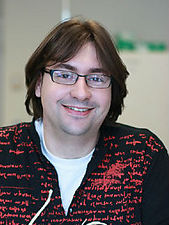Mouse TRIP13/PCH2 is required for recombination and normal higher-order chromosome structure during meiosis Journal Article
| Authors: | Roig, I.; Dowdle, J. A.; Toth, A.; De Rooij, D. G.; Jasin, M.; Keeney, S. |
| Article Title: | Mouse TRIP13/PCH2 is required for recombination and normal higher-order chromosome structure during meiosis |
| Abstract: | Accurate chromosome segregation during meiosis requires that homologous chromosomes pair and become physically connected so that they can orient properly on the meiosis I spindle. These connections are formed by homologous recombination closely integrated with the development of meiosis-specific, higher-order chromosome structures. The yeast Pch2 protein has emerged as an important factor with roles in both recombination and chromosome structure formation, but recent analysis suggested that TRIP13, the mouse Pch2 ortholog, is not required for the same processes. Using distinct Trip13 alleles with moderate and severe impairment of TRIP13 function, we report here that TRIP13 is required for proper synaptonemal complex formation, such that autosomal bivalents in Trip13-deficient meiocytes frequently displayed pericentric synaptic forks and other defects. In males, TRIP13 is required for efficient synapsis of the sex chromosomes and for sex body formation. Furthermore, the numbers of crossovers and chiasmata are reduced in the absence of TRIP13, and their distribution along the chromosomes is altered, suggesting a role for TRIP13 in aspects of crossover formation and/or control. Recombination defects are evident very early in meiotic prophase, soon after DSB formation. These findings provide evidence for evolutionarily conserved functions for TRIP13/Pch2 in both recombination and formation of higher order chromosome structures, and they support the hypothesis that TRIP13/Pch2 participates in coordinating these key aspects of meiotic chromosome behavior. © 2010 Roig et al. |
| Keywords: | controlled study; unclassified drug; nonhuman; protein function; animal cell; chromosome structure; mouse; synaptonemal complex; meiosis; animals; cell cycle proteins; mice; mice, knockout; animal tissue; cell line; mice, inbred c57bl; evolution, molecular; nuclear proteins; genetic recombination; recombination, genetic; double stranded dna break; saccharomyces cerevisiae proteins; saccharomycetales; adenosine triphosphatase; chromosome chiasm; chromosome pairing; synapsis; adenosine triphosphatases; genetic conservation; chromosome segregation; prophase; crossing over; crossing over, genetic; receptor protein; chromosomes, mammalian; pachytene checkpoint 2 protein; thyroid hormone receptor interacting protein 13; chromosome bivalent; sex chromosome; structural chromosome aberration |
| Journal Title: | PLoS Genetics |
| Volume: | 6 |
| Issue: | 8 |
| ISSN: | 1553-7390 |
| Publisher: | Public Library of Science |
| Date Published: | 2010-08-12 |
| Start Page: | e1001062 |
| Language: | English |
| DOI: | 10.1371/journal.pgen.1001062 |
| PUBMED: | 20711356 |
| PROVIDER: | scopus |
| PMCID: | PMC2920839 |
| DOI/URL: | |
| Notes: | --- - "Cited By (since 1996): 1" - "Export Date: 20 April 2011" - "Source: Scopus" |
Altmetric
Citation Impact
BMJ Impact Analytics
MSK Authors
-
 139
139Keeney -
 17
17Roig Navarro -
 251
251Jasin -
 2
2Dowdle
Related MSK Work



